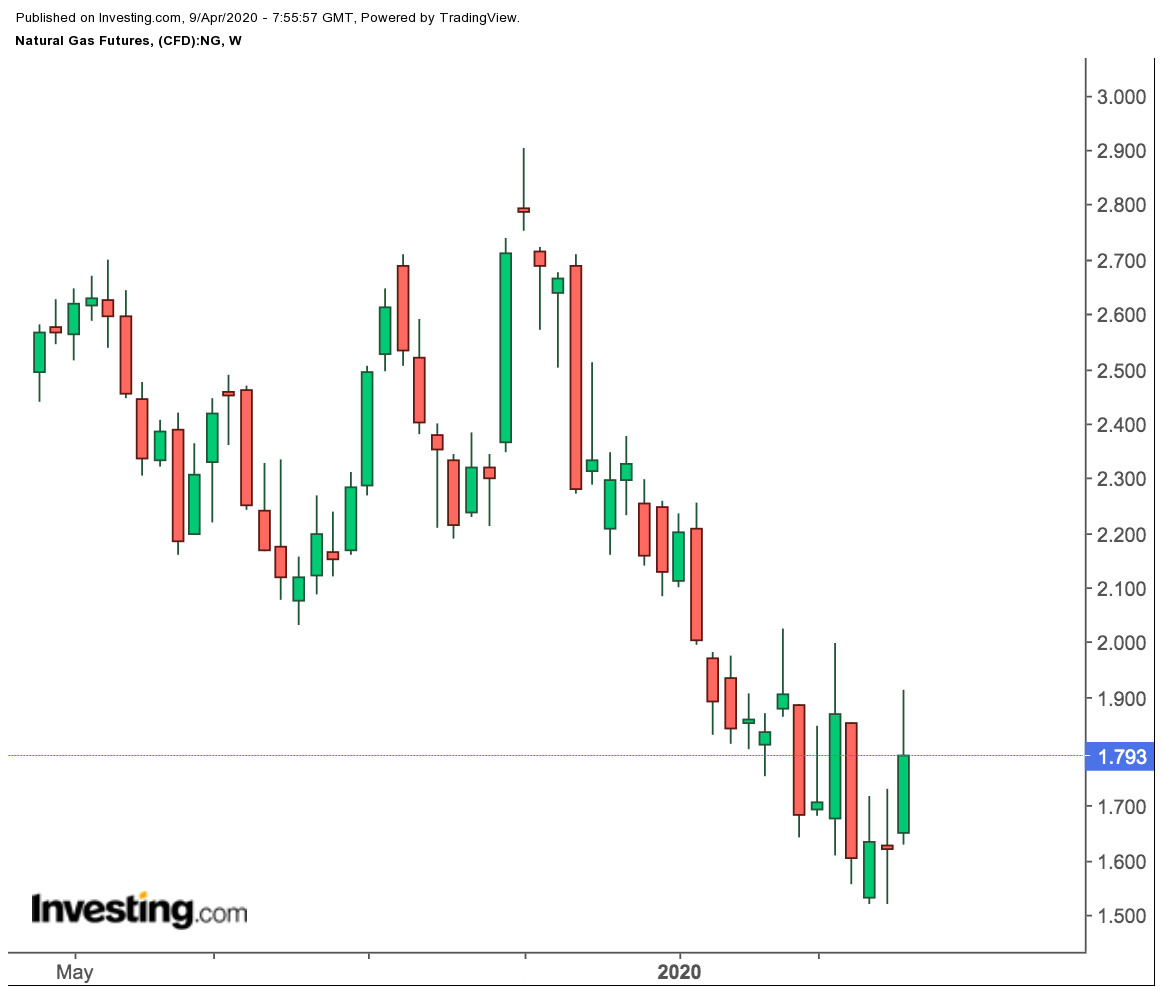A potential end to 17 weeks of storage draws in U.S. natural gas looms as power burns suddenly jump and temperatures beckon lower. The conflicting trends have revived volatility in a commodity often known as the bucking bronco of the energy market.
Natural gas was so sluggish a couple of weeks ago that the front-month contract on the New York Mercantile Exchange’s Henry Hub was barely moving beyond 5 cents per million metric British thermal units — either way.
All that changed in three rocket-like sessions between Friday and Tuesday — before Wednesday’s dip, of course — that added a net 23 cents, or 15%, to the front-month. Despite some longs bolting in the last session on fear of a sudden reversal, the front-month reached a seven-week high of $1.918 per mmBtu on Wednesday. 
Although still early in the day, if this momentum persists, April could become the first positive month in six for natural gas.
Bears Leave Wheel, Bulls In Charge
Gas bears, roaring just a week ago at the prospect of taking the market deeper down the abyss after 25-year lows of $1.52 per mmBtu for the front month, have left the wheel for now.
In their place are gas bulls looking a little more menacing with sharpened horns, and waging for a return of $2 gas during a season of typically milder temperatures not known to require inordinate heating or cooling. Also, as long as much of America stays in lockdown over the coronavirus, the continued rate of high power burns remains debatable.
What’s more stunning is some bulls are actually rejecting the idea that gas in storage could have seen its first build in 18 weeks last week. A consensus of gas analysts tracked by both Investing.com and Reuters show an injection of 24 billion cubic feet into storage for the week ended April 3.
“Overall, the talk on the April injection at this point is looking lower and lower due to the weather and sticky demand from power and industrial demand, which is quite contrary to the state of the rest of the world energy markets and likely has caught some shorts,” Scott Shelton, energy futures broker at ICAP in Durham, North Carolina. “If I was trading it, I would have been one of them.”
Debate Over Production
Shelton noted that power demand was at seasonal highs, nearing 30 billion cubic feet (bcf) per day, while capital expenditure cuts by shale gas drillers such as Marathon Oil (NYSE:MRO) — which has dropped its capex by 50% from 2019 levels — should support the narrative of falling production.
He adds:
“Bottom line is that the market continues to hold up demand wise despite the COVID-19 virus and benefitting from optimism on lower production and better April demand from weather. $2 looks rich to me, but so did $1.75 as I got the demand side completely wrong.”
But production has not yet fallen.
Until last week, gas production in the lower 48 U.S. states averaged 93.14 bcf per day — up from the previous week’s average of 92.92 bcf.
Cold Forecasts Holding Up Market
What is the weather forecast then?
Dominick Chirichella of the New York-based Energy Management Institute says a below-normal colder regime will ensue from Friday — affecting most areas in Central/Eastern U.S. from days 5 through 15, with the most frigid impact on the Central U.S.
“In general, the moderation should continue past the day 11-15 period and we are anticipating a return to warmer temperatures before the end of April,” Chirichella said.
Dan Myers of Houston-based consultancy Gelber & Associates agrees that below-normal temperatures would remain the focus now for gas traders, although “a couple of larger-than-average storage increases, the very first injections of the season” loom large.
“G&A is forecasting a 9 bcf injection in tomorrow’s storage report,” Myers wrote in a report on Tuesday, referring to his firm’s idea for the inventory level, which he admitted was on the low side of expectations but still larger than the 6 bcf five-year average for injections at this time of year.
He said production could slip to 92 bcf per day by end-April as export demand to Mexico and for LNG retreated from recent highs.
The Energy Information Administration, in its Short-Term Energy Outlook (STEO) released this week, concurred that industrial and LNG export demand will endure weakness for the rest of the year from uncertainty and reduced economic activity.
Stay-Home Orders Seen Hitting Commercial Gas Demand
Not only that, demand could fall in most sectors, as warm Q1 temperatures and stay-at-home orders reduce especially commercial demand for gas, the EIA’s STEO report said.
But one area of domestic demand still expected to grow thanks to low prices is natural gas-fired power demand, despite forecasts for a 3% reduction in overall power generation in 2020, the report said.
Notably on the supply side, the EIA forecast 2020 dry gas production to average 91.7 bcf per day, about 0.5 bcf per day lower than 2019, saying those reduced production levels could extend into 2021.
Overall, demand impacts are expected to be mostly contained to Q2 and Q3, keeping Henry Hub flat at $2.11 mmBtu for all of 2020, the EIA said. However, significant supply reductions going into next year also convinced the government’s energy arm to include a notable, 47-cent upward revision to its 2021 forecast for the Henry Hub front-month to $2.98 per mmBtu.
* Disclaimer: Barani Krishnan does not own or hold a position in the commodities or securities he writes about.
